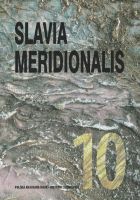Sylaba w gwarze Moravy e Epërme
Syllable pattern in Morava e Epërme local dialect of Albanian
Author(s): Karolina DargielSubject(s): Language and Literature Studies
Published by: Instytut Slawistyki Polskiej Akademii Nauk
Keywords: syllable pattern; Albanian; Kosovo dialects; homorganic clusters; vowel schwa.
Summary/Abstract: This article summarizes the first part of a research on syllable pattern in Kosovo dialects. It attempts to answer the question, whether Kosovo dialects have onepeak syllable pattern, twopeak syllable pattern or maybe some other type. Facing many theories about the syllabic unit, that have been created until now, for our study we choose the sonority theory, which is a very comfortable model for formulating distributional rules of speech sounds. Standard Albanian language is untypical against other European languages. This is due to the fact that it tolerates twopeak homorganic consonant clusters [NO] in word initial position (mb, mp, nd, ŋg, nʣ, ɲɟ). Twopeak clusters in word final position are not accepted; consonants are always separated by vowel [ә]. What we observe in Standard Albanian is rather onepeak syllable pattern, where the hierarchy of sonority in the syllable is obeyed, but the least sonorous nasal sonorants should be classified to the distributional group of obstruents. And how does it look like in other Albanian dialects? For our study we have chosen several Kosovo dialects, which seem the most relevant for the examined problems. In this article I deal with the local dialect of Morava e Epërme, where I have studied the following issues: – [SO] initial clusters (including clusters with liquids l and rr), – *[OS] final clusters, – Clusters [OSO] with an interobstruental sonorant, – Consonantal proclitics on strong morphological borders (t’, m’, n’, s’), – Occurences of vowel [ә]. Does it have phoneme status in this local diAlect? – Can sonorants and obstruents be syllabic? Our study has proved, that [NO] initial clusters have tendency for reduction: [mbyt], [ŋuʃt] instead of [mbyt], [ŋguʃt, whereas sporadic occurence of the twopeak initial clusters lO, rrO is phonetically conditioned (it means that this form occurs only after vowels [m‿ka‿ʎʃu:], [mu‿Rʣu:]). Final *[OS] clusters in Morava e Epërme, as in the standard Albanian, are completely extinct (they are usually split by vowel [ә]: [vetәm ktu], [natәn], [θupәr]). The same referes to the clusters [OSO], which usually occur with the syllabic sonorant or inserted vowel schwa [ә]. Dialect of Morava e Epërme tolerates syllabic sonorants and in some contexts also syllabic obstruents. The vowel [ә] appears very often, but never in unmotivated position. Therefore we can conclude that this sound does not have the phoneme status in this dialect. Dialect of Morava e Epërme neither has the typical onepeak syllable pattern (it tolerates twopeak initial clusters), nor it has a twopeak syllable model (it does not tolerate twopeak final clusters). This local dialect can be classified, the same as standard Albanian, as a one with onepeak syllable pattern, where, however, nasal sonorants should be distributionally classified as obstruents (and not as sonorants).
Journal: Slavia Meridionalis
- Issue Year: 2010
- Issue No: 10
- Page Range: 53-68
- Page Count: 16
- Language: Polish

